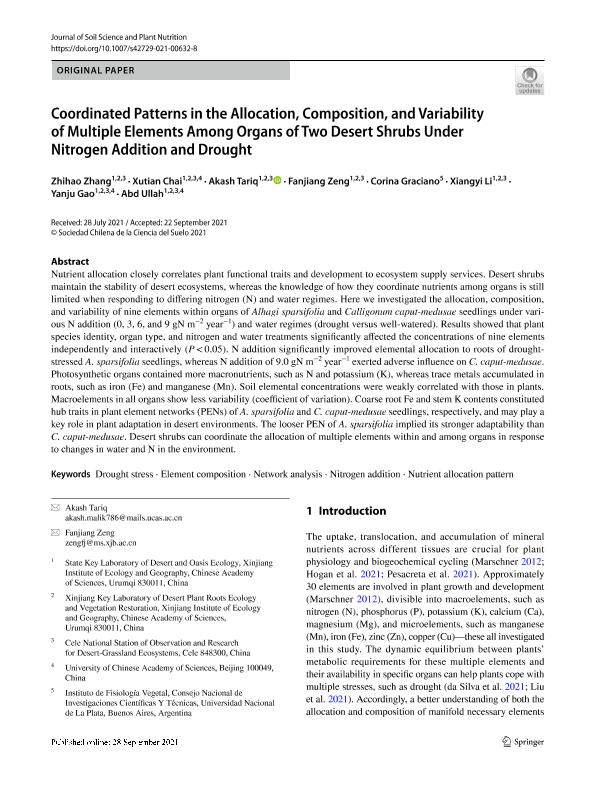Artículo
Coordinated Patterns in the Allocation, Composition, and Variability of Multiple Elements Among Organs of Two Desert Shrubs Under Nitrogen Addition and Drought
Zhang, Zhihao; Chai, Xutian; Tariq, Akash; Zeng, Fanjiang; Graciano, Corina ; Li, Xiangyi; Gao, Yanju; Ullah, Abd
; Li, Xiangyi; Gao, Yanju; Ullah, Abd
 ; Li, Xiangyi; Gao, Yanju; Ullah, Abd
; Li, Xiangyi; Gao, Yanju; Ullah, Abd
Fecha de publicación:
09/2021
Editorial:
Springer Science and Business Media Deutschland GmbH
Revista:
Journal of Soil Science and Plant Nutrition
ISSN:
0718-9508
e-ISSN:
0718-9516
Idioma:
Inglés
Tipo de recurso:
Artículo publicado
Clasificación temática:
Resumen
Nutrient allocation closely correlates plant functional traits and development to ecosystem supply services. Desert shrubs maintain the stability of desert ecosystems, whereas the knowledge of how they coordinate nutrients among organs is still limited when responding to differing nitrogen (N) and water regimes. Here we investigated the allocation, composition, and variability of nine elements within organs of Alhagi sparsifolia and Calligonum caput-medusae seedlings under various N addition (0, 3, 6, and 9 gN m−2 year−1) and water regimes (drought versus well-watered). Results showed that plant species identity, organ type, and nitrogen and water treatments significantly affected the concentrations of nine elements independently and interactively (P < 0.05). N addition significantly improved elemental allocation to roots of drought-stressed A. sparsifolia seedlings, whereas N addition of 9.0 gN m−2 year−1 exerted adverse influence on C. caput-medusae. Photosynthetic organs contained more macronutrients, such as N and potassium (K), whereas trace metals accumulated in roots, such as iron (Fe) and manganese (Mn). Soil elemental concentrations were weakly correlated with those in plants. Macroelements in all organs show less variability (coefficient of variation). Coarse root Fe and stem K contents constituted hub traits in plant element networks (PENs) of A. sparsifolia and C. caput-medusae seedlings, respectively, and may play a key role in plant adaptation in desert environments. The looser PEN of A. sparsifolia implied its stronger adaptability than C. caput-medusae. Desert shrubs can coordinate the allocation of multiple elements within and among organs in response to changes in water and N in the environment.
Archivos asociados
Licencia
Identificadores
Colecciones
Articulos(INFIVE)
Articulos de INST.DE FISIOLOGIA VEGETAL
Articulos de INST.DE FISIOLOGIA VEGETAL
Citación
Zhang, Zhihao; Chai, Xutian; Tariq, Akash; Zeng, Fanjiang; Graciano, Corina; et al.; Coordinated Patterns in the Allocation, Composition, and Variability of Multiple Elements Among Organs of Two Desert Shrubs Under Nitrogen Addition and Drought; Springer Science and Business Media Deutschland GmbH; Journal of Soil Science and Plant Nutrition; 22; 1; 9-2021; 47-58
Compartir
Altmétricas



